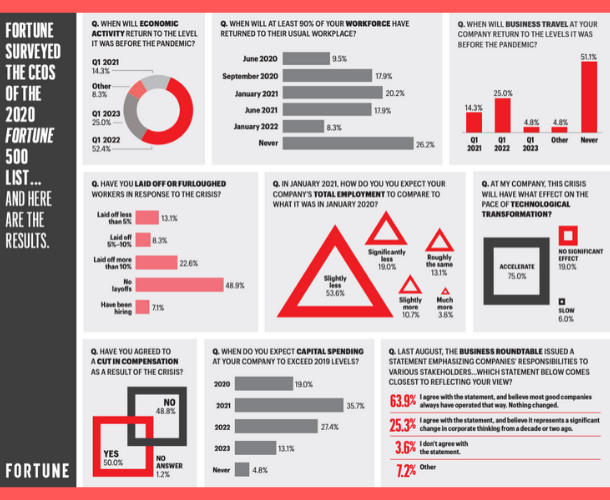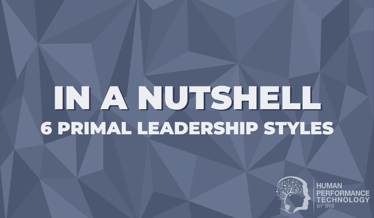Are You In A Rush Back To The Office... Exclusive Insights From The Fortune 500 CEOs
Now that restrictions are easing, and in accordance with your plans, when will at least 90% of your workforce return to their usual workplace? Over 26% of the CEOs of the Fortune 500 companies answered this question with “Never”.
Let’s Start from the Beginning
Intense focus and effort was made to effectively transition our people to an effective ‘remote working’ model. While models varied business-to-business, all businesses complied as this was time-sensitive and critical for our health from March 2020.
Plans were outlined, re-worked, put into effect and sustained for months. Many reflect back with deep respect for our HR, OD and Change professionals who worked tirelessly and enabled one of the biggest organisational and social changes of our time.
When we enact such a large-scale change under a veil of uncertainty, we naturally look to cling to ‘the way things were’. It’s actually a grieving process.
So when restrictions eased and business districts re-opened, plans were laid to bring employees back into the office; however, there appears to be some flawed thinking in the rush to return! Let’s explore a couple of themes based on the data from Fortune. [1]

What is this infographic telling us?
Theme 1: Fewer employees...44% laid off or furloughed workers.In anticipation of January 2021, 72.6% expect total employment to be less than it was at the start of 2020.It will take 18 more months for only 73.8% of the workforce to return to their usual workplace.
Theme 2: Money will be invested...54% expect capital spending to exceed 2019 levels by 2021, and the return will be seen predominantly in the following year in Q1 2022.This investment is likely to be put toward technological transformation with 75% accelerating those efforts.Over 50% expect business travel will never return to the previous level.
The Fortune 500 is the ranking of America’s largest companies. Fortune’s Global 500 includes seven Australian businesses. While the data collected in this survey was taken from the CEOs of the Fortune 500, their businesses are global and often used as a benchmark for emerging practices (e.g. Apple, Amazon, Alphabet Inc.)
What opportunities are created?
While these outcomes are predicted on a global scale by American businesses, let’s connect the dots to the opportunities here in Australia.
Theme 1: Fewer employees can lead to opportunities for automation and the transition to the future of work, which incorporates on- and off- balance sheet workers.*
Theme 2: Money will be invested in technology transformation, which creates the opportunity for an effective dispersed workforce and customer service.
What actions can be taken now and over the coming 6 months?
The intentions of these actions are to spark ideas for you so that you can apply them to your business.
Theme 1: Fewer employees creates opportunities for automation and the transition to the future of work, which incorporates on- and off- balance sheet workers.* Actions taken now and over the next 6 months should reflect preparations for a new workforce that incorporates artificial intelligence (AI) for automation.
Potential Actions:
- Where roles have been left vacant due to lay-offs or where there is immense administrative pressure, plan to automate repetitive tasks.
- Where tasks are automated, identify the employees who will be freed up for more challenging tasks. Plan to up-skill employees and grow the staff on the balance sheet.
- Determine what areas of the business are appropriate for partnerships with freelancers and consultants.
Theme 2: Money will be invested in technology transformation, which creates the opportunity for an effective dispersed workforce and customer service. Actions taken now and over the next 6 months should reflect preparations for retaining talent and supporting performance in a dispersed team environment, as well as additional up-skilling for the future of work.
Potential Actions:
- Propose new reward packages that incorporate a stipend for employees’ home office. Consider taking the budget from the business's reduced commercial lease (which will decrease in need and purpose) and putting it towards staff benefits.
- Start now in the move towards creating a business culture that is adept in change - a culture that expects to evolve and has the hard and soft skills to transform.
- Prepare employees to serve customers effectively with a mix of AI and human empathy. It’s a fascinating mix and important balance to get right.
- Outcomes based employee performance review that does not rely heavily on direct observation from a manager.
In many ways, it’s exciting to see us (as a broader business community) accelerate in this way towards the future of work. According to Deloitte Consulting, the future of work is being shaped by two powerful forces: The growing adoption of artificial intelligence in the workplace, and the expansion of the workforce to include both on- and off-balance-sheet talent. [2]
Linking that definition to the Fortune data indicates a swift move in that direction. It will require a shift in approach to workforce strategy, organisational change and more.
Will you embrace the new reality or maintain the status quo? Talk to us about strategic workforce planning and transformation management!
Note: These are anecdotal correlations and don’t necessarily result in a causal relationship. Nonetheless, it is food for thought on how to approach your workforce strategy.
References
[1] Alan Murray, Fortune 500 CEO survey: How are America’s biggest companies dealing with the coronavirus pandemic? May 14, 2020.
[2] Deloitte, Collection: Future of Work. 2020.

Temre Green, PhD
Head of Consulting Services, Australia & New Zealand. Temre has designed, planned and delivered business strategy and transformation programs that were driven by a range of factors, such as innovation, growth, compliance, regulations, restructures and economic downturns. As an Industrial-Organisational Psychologist, Temre has spent her career dedicated to organisational behaviour and the work environment. She is currently focused on the future of work and multiple areas of organisational development that support organisational growth and health.



We Would Like to Hear From You (0 Comments)